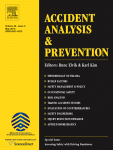A considerable amount of all traffic accidents can be attributed to driving under the influence of alcohol.
In particular the group of drivers aged 18–24 years is involved in many serious traffic accidents where alcohol turns out to be a major factor. In fact this age group shows about three times as many alcohol related traffic fatalities as all other categories of road users.
The intervention program “Alcohol-free on the road” (Dutch: “Alcoholvrij op weg”) aims to enhance young people's awareness of the effects of alcohol by letting them personally experience the effect of alcohol on their driving abilities.
To this end, young drivers were invited to a closed circuit and allowed to drive first sober and then intoxicated, guided and guarded by driving instructors.
Based on several other studies it was thought that a realistic experience of the effects of alcohol on driving abilities may contribute to a better understanding of the impact of alcohol and may stimulate attitudes that are needed to support the conscious decision not to drive while intoxicated.
After more than ten years of running and data collection, 1200 young drivers have participated in the intervention program. In a quasi-experimental study with a non-equivalent group design, the program is evaluated in order to assess its effectiveness both with respect to the attitudes of the participants and the actual relevant behaviour in the years after the alcohol experience intervention program they attended, i.e. the incidence of actually driving under the influence of alcohol.
To do this, a questionnaire was sent to a subset (415) of the participants who have completed the program, along with a control group (450), to compare attitudes and actual behaviour. In addition, the Public Prosecutor checked the files of those who responded, for the occurrence of driving under the influence of alcohol.
The group that participated in the alcohol intervention program showed more awareness about the dangers of driving while intoxicated than the control group, and this group reported improved alcohol law compliance.
Furthermore, less participants in the intervention program than in the control group were present in the Public Prosecutor files, respectively 0.7% and 4.2%. Hence, the alcohol driving experience intervention program might turn out to be effective and successful in decreasing driving under the influence of alcohol.
Although the results of the present study are no more than suggestive, they may be considered a first step towards demonstrating the effectiveness of this type of intervention.
However, the intervention is unique and warrants a more robust evaluation. A large-sized randomized controlled trial should be conducted in the next phase to confirm the findings that the intervention program is a suitable educational tool to decrease driving under the influence of alcohol.
The present paper serves to raise awareness of this intervention and its potential.
Read Full Abstract
Request Reprint E-Mail: K.A.Brookhuis@rug.nl
In particular the group of drivers aged 18–24 years is involved in many serious traffic accidents where alcohol turns out to be a major factor. In fact this age group shows about three times as many alcohol related traffic fatalities as all other categories of road users.
The intervention program “Alcohol-free on the road” (Dutch: “Alcoholvrij op weg”) aims to enhance young people's awareness of the effects of alcohol by letting them personally experience the effect of alcohol on their driving abilities.
To this end, young drivers were invited to a closed circuit and allowed to drive first sober and then intoxicated, guided and guarded by driving instructors.
Based on several other studies it was thought that a realistic experience of the effects of alcohol on driving abilities may contribute to a better understanding of the impact of alcohol and may stimulate attitudes that are needed to support the conscious decision not to drive while intoxicated.
After more than ten years of running and data collection, 1200 young drivers have participated in the intervention program. In a quasi-experimental study with a non-equivalent group design, the program is evaluated in order to assess its effectiveness both with respect to the attitudes of the participants and the actual relevant behaviour in the years after the alcohol experience intervention program they attended, i.e. the incidence of actually driving under the influence of alcohol.
To do this, a questionnaire was sent to a subset (415) of the participants who have completed the program, along with a control group (450), to compare attitudes and actual behaviour. In addition, the Public Prosecutor checked the files of those who responded, for the occurrence of driving under the influence of alcohol.
The group that participated in the alcohol intervention program showed more awareness about the dangers of driving while intoxicated than the control group, and this group reported improved alcohol law compliance.
Furthermore, less participants in the intervention program than in the control group were present in the Public Prosecutor files, respectively 0.7% and 4.2%. Hence, the alcohol driving experience intervention program might turn out to be effective and successful in decreasing driving under the influence of alcohol.
Although the results of the present study are no more than suggestive, they may be considered a first step towards demonstrating the effectiveness of this type of intervention.
However, the intervention is unique and warrants a more robust evaluation. A large-sized randomized controlled trial should be conducted in the next phase to confirm the findings that the intervention program is a suitable educational tool to decrease driving under the influence of alcohol.
The present paper serves to raise awareness of this intervention and its potential.
Read Full Abstract
Request Reprint E-Mail: K.A.Brookhuis@rug.nl
